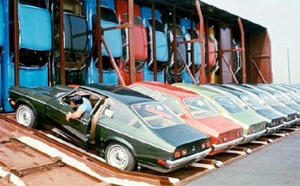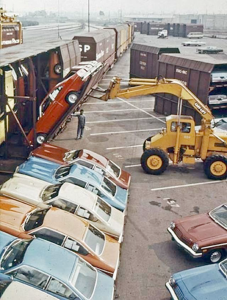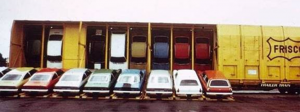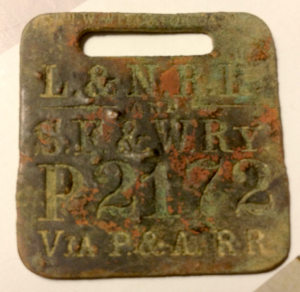 by Rick Bivins, Chapter President
by Rick Bivins, Chapter President
Hello again Chapter Members and welcome to June, 2013. As some of you will recall, May found us in Hopkinsville KY. as guests of our Hopkinsville Members. Our meeting was held in the former Louisville & Nashville Passenger Station which is a wonderful venue. The weather was perfect, many members were on hand and CSX provided us with a few trains, one being an ICE (Iowa, Chicago & Eastern) run-through no less! And of course we had food! Boy did we have food. Mr. Ferrell and his staff went all out with burgers, dogs and all the trimmings. WHEW!
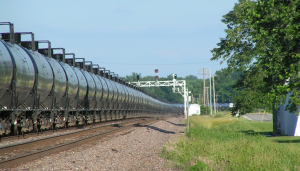 Change came about the meeting unexpectedly but with a positive outcome. The program was to be presented by Cliff Downey. The subject was to be Illinois Central’s KY Division. However, Cliff was called into work at the last minute to make repair of a hospital machine that was evidently needed right away. We certainly do not fault him for that. Cliff expressed his grief but he has been assured a program slot of his choosing in the near future. In place of our usual program time we simply enjoyed good food, camaraderie and relaxed. We did take time out to have a business meeting. Discussion was had on the upcoming Chapter Train Ride in Tennessee along the former Tennessee Central, Friday Night Live, the scuttled Progress Rail trip and………
Change came about the meeting unexpectedly but with a positive outcome. The program was to be presented by Cliff Downey. The subject was to be Illinois Central’s KY Division. However, Cliff was called into work at the last minute to make repair of a hospital machine that was evidently needed right away. We certainly do not fault him for that. Cliff expressed his grief but he has been assured a program slot of his choosing in the near future. In place of our usual program time we simply enjoyed good food, camaraderie and relaxed. We did take time out to have a business meeting. Discussion was had on the upcoming Chapter Train Ride in Tennessee along the former Tennessee Central, Friday Night Live, the scuttled Progress Rail trip and………
Speaking of Friday Night Live, by the time you read this our first FNL (June 14) may be behind us. Expect a report there on. However, we will set up our table at the July 8th and August 9th events. Again, we have a great time with kids and adults, spread the word of our Organization and help our fair City. So please try to attend at least one of the three events if only for an hour or so. Those of us that are on hand EVERY time could use a brake every once in a while! Matt Gentry hand delivered our calling cards and they look great. I will have them on hand meeting night. We will hand these out during our visits with event goers etc.
And speaking of events, our annual Fall picnic is set for Saturday, September 28th, 2013. This is a great time of trains, food and fellowship.
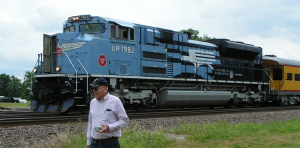 On Monday June 3rd, 2013, four of us, Wally Watts, Thomas Bryan, Matt Gentry and I met up with Gary Ostlund in Gorham IL. To watch trains and talk trains (Army, cars, trucks etc.) for the day. I had planned this around Gary’s regular trip to the VA Clinic in Marion IL. Gary drives his Motor Home to Gorham with his VW in tow and spends a few days track side at Gorham. Also in Gorham is Chuck (Black Pete), a lifelong resident of the sleepy little town. Chuck (whose last name escapes me now) is a twice retired store house of information. While watching trains (or empty track for seven hours as it was) we learned of a track maintenance curfew for the day. BUT…we were rewarded with a Union Pacific Passenger train!!! A Safety Special to promote grade crossing awareness in Illinois and Missouri. The south bound train had the UP CNW Heritage unit in the lead, three passenger cars and the MoPac Heritage unit trailing. The train stopped in Gorham, the crew changed units and the train departed north bound. There was a lot of photo’s, ogling and waves to/from passengers as we took in the scene. It was a really good day with friends and trains regardless of the lack of regular trains. Perhaps we can make this a Chapter Function…anyone?
On Monday June 3rd, 2013, four of us, Wally Watts, Thomas Bryan, Matt Gentry and I met up with Gary Ostlund in Gorham IL. To watch trains and talk trains (Army, cars, trucks etc.) for the day. I had planned this around Gary’s regular trip to the VA Clinic in Marion IL. Gary drives his Motor Home to Gorham with his VW in tow and spends a few days track side at Gorham. Also in Gorham is Chuck (Black Pete), a lifelong resident of the sleepy little town. Chuck (whose last name escapes me now) is a twice retired store house of information. While watching trains (or empty track for seven hours as it was) we learned of a track maintenance curfew for the day. BUT…we were rewarded with a Union Pacific Passenger train!!! A Safety Special to promote grade crossing awareness in Illinois and Missouri. The south bound train had the UP CNW Heritage unit in the lead, three passenger cars and the MoPac Heritage unit trailing. The train stopped in Gorham, the crew changed units and the train departed north bound. There was a lot of photo’s, ogling and waves to/from passengers as we took in the scene. It was a really good day with friends and trains regardless of the lack of regular trains. Perhaps we can make this a Chapter Function…anyone?


